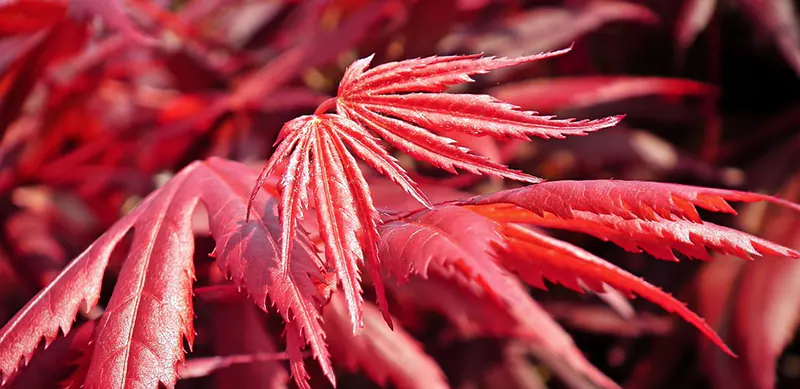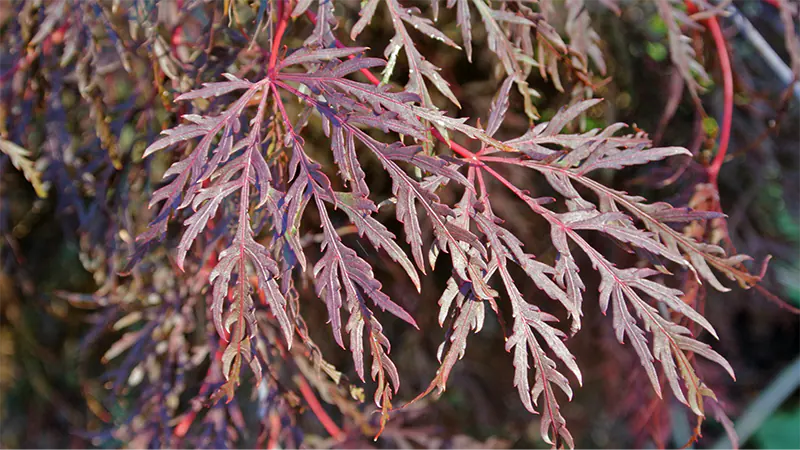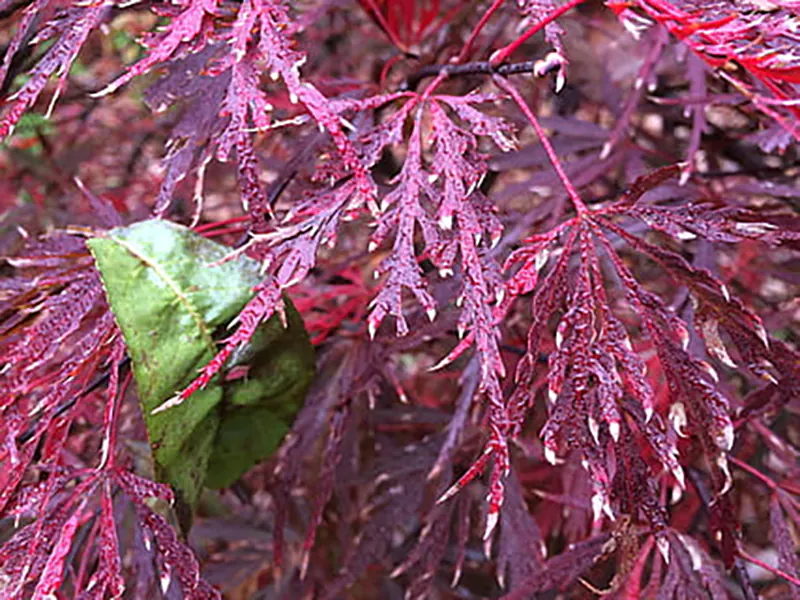Inaba-shidare Japanese Maple
A gorgeous cascading bonsai, the Inaba-shidare Japanese maple is a great tree to begin growing. Whether you’re a bonsai expert or a newcomer to the trade, we’ll explain all the information you need to care for the tree.
The bonsai has pretty reddish and pink foliage that makes it an excellent option to grow for decor inside or outside. However, this leaf coloring can be hard to keep due to the heat and other environmental issues. We’ll explain how to help your foliage stay a gorgeous hue.
Here's what you'll find while reading our Inaba-shidare Japanese maple bonsai species care sheet:
Here's what you'll find while reading our Inaba-shidare Japanese maple bonsai species care sheet:
01
02
03
04
05
Quick Inaba-Shidare Japanese Maple Bonsai Care Sheet
The following table is a great, shortened version of the article for a quick overview. You can find the basics of everything you need below.
Recommended soil | Akadama mixture or another well-draining option. |
Watering | Once a day, potentially more frequently. |
Potting season | Every second year. |
Shaping and pruning season | Once every two years for finer branches. Large branches during autumn. |
Light | Plenty per day. Preferably avoiding afternoon sun. |
Fertilizing | Solid organic fertilizer. Low nitrogen levels are advised to prevent large leaves. |
Propagation methods | Seeds, air layering, and cuttings. |
Pests and diseases | Aphids and verticillium wilt are among the most common. |
How To Care For An Inaba-Shidare Japanese Maple Bonsai
In this section, we’ll explain in detail all the requirements listed in the quick guide table. We walk you through all the details and steps from soil to pruning and repotting.
Best Soil
The best soil you can use for your Inaba-shidare Japanese maple bonsai is an akadama mixture with lava rocks and pumice. The mixture will help retain soil moisture without harming the roots. Additionally, as it retains moisture, it will also hold nutrients for longer.
Alternatively, any well-draining option will suffice if you’re looking for easier-to-find bonsai soil. This choice will help prevent any issues because your roots are kept too wet.
Watering
As a Japanese maple, the Inaba-shidare requires daily watering. On most days, you’ll need to water your bonsai at least once, if not more frequently.
Using a better soil mixture will lessen the amount of watering your bonsai needs each day. Additionally, temperature and sunlight exposure will affect how often your tree requires water. Touch your finger to the soil to ensure you don’t overwater the tree.
Repotting
The Inaba-shidare Japanese maple requires a repotting every second year, as it will often outgrow its container within this short period. Regardless of the tree’s age, the roots will always grow rapidly. As such, they fill the container and need to be trimmed within two years, an act that helps maintain the tree’s health and longevity.
While pruning the tree’s roots, use a pencil or toothpick to help untangle the roots for pruning. Wash your pot and ensure it dries well. Check the tree’s roots for any sign of damage from overwatering or otherwise, and cut off the afflicted parts.
Shaping And Pruning
Cut paste is essential when pruning the larger branches during the autumn season. These branches become prone to infection when cut and need the paste to help lessen the risk and stress from the cutting. Smaller parts such as twigs and leaves will place less stress on the tree during any time of year. However, you should only trim these smaller pieces every two years for the best effect on growth.
Sunlight And Location
Place the tree in a well-lit area that gets plenty of sunlight during the morning hours. The afternoon sun can cause damage to the tree, especially during the summer months. Warm temperatures during summer can cause your leaves to turn green, fading away from their reddish hue.
When temperatures reach nearer to freezing, the tree needs to be sheltered during the winter. While somewhat resistant to the cold, it will begin to suffer if left out too long. Generally, moving the tree inside or into a sheltered area that receives enough light helps the tree survive cold winters.
Fertilizing
Solid organic fertilizer with a low nitrogen content is the best option to use when growing an Inaba-shidare maple. High nitrogen content in the fertilizer will cause the leaves to grow larger than normal and is likely to affect the appearance of your bonsai. If your tree’s growing well, you can add a small amount of liquid fertilizer each week to improve the mixture’s effectiveness.
Propagation Methods
You can use seeds, cuttings, and air layering to grow a new Inaba-shidare Japanese bonsai. However, these methods will work best during autumn. All the methods work well, leaving the decision to your preference.
Pests And Diseases
Aphids are a nuisance you’ll have to deal with while growing the Inaba-shidare Japanese maple. These sap-suckers harm your tree’s health, drinking its nutrients. As they can cause an infestation, you’ll need to learn how to avoid them. Frequently misting your tree keeps the aphids away, and common insecticide can remove an infestation.
Additionally, verticillium wilt is a fungal infection you may get on your Inaba-shidare bonsai. This infection has no cure and can kill your tree if you don’t take action. If you see any leaves begin to wilt, trim the infected area away. Keep the bonsai well-watered and receiving fertilizer for extra nutrients to help it survive.
Image courtesy of James Steakley
Considerations For Growing An Indoor Inaba-Shidare Japanese Maple
Growing any bonsai indoors requires a few extra considerations. For the Inaba-shidare Japanese maple, you’ll need to pay specific attention to the placement and watering needs of the tree.
Watering
The Japanese maple species are known to be thirsty, requiring water at least once a day. Often, during warmer weather, you’ll need to increase this frequency. However, while doing this, it’s entirely possible to overwater the tree if you aren’t paying attention.
Being indoors in a controlled environment will affect the amount of water the bonsai needs. With less sun exposure and a cooler room temperature, you may only need to water the tree once a day.
Placement
Ensure the tree is in an area that receives plenty of sunlight each day, preferably morning sun, as the afternoon’s light can affect the bonsai’s foliage. A sun-facing window is the best location for the tree, but a desk that gets a few hours of sun each day will work just as well.
Common Issues You’ll Encounter While Caring For A Red Dragon Japanese Maple Bonsai
Watering is a common issue most new growers encounter with any bonsai. However, the Inaba-shidare Japanese maple has a high watering frequency. Without careful attention, it’s easy to under or over-water your bonsai.
Watering
Watering is your most commonly seen issue with the Inaba-shidare maple, as it often requires more water than just once per day. Once you begin to water it more frequently, it’s easy for this to become a habit. During cooler days, when the soil retains more moisture, you’ll begin over-watering the tree. This process will cause damage to its roots and, if continued for too long, may lead to the tree’s death.
FAQs About Inaba-Shidare Japanese Maple Bonsai
Here are several frequently asked questions that will help you understand how to care for the Inaba-shidare Japanese maple. Here we’ll explain the tree’s name, if you can grow it indoors, and whether you should keep this tree in the sun or shade.
The Inaba-shidare Japanese maple has a more unique name than many other trees in the species. The translation of Inaba-shidare translates to cascading, referring to the bonsai’s foliage.
The Inaba-shidare Japanese maple is a great tree to start growing indoors as it takes well to most environments you place it in. However, the tree has a few requirements that you must meet. Ensure the bonsai receives plenty of sunlight in a well-aired location and water at least once a day. With these needs met, the tree will grow well indoors.
The Inaba-shidare Japanese maple prefers morning sunlight with afternoon shade. This shade protects your tree’s leaves from damage and helps maintain the reddish color of its leaves. The tree requires a few hours of sunlight exposure each day to survive.







